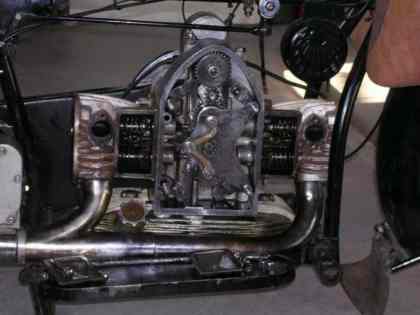Howdy ya’ll,
First: What is the valves lash dimension for this 1932 T6 Douglas?
Second: Alwyn asked me a few questions last fall (fall in the USA), to which I will now respond.
In review, I am the foster parent/mechanic/caretaker for this motorcycle, which was inherited by, my friend, Travis Fulton, a son of Robert Edison Fulton, Jr. I made those photos in my front yard.
On display somewhere? Not formally, but if you’re in the Rocky Mountains, contact me and I’ll facilitate your opportunity to check out this historical moto.
Adventure touring on a late model GS? Bah. Fulton’s was the epic adventure tour!
Presently, there is no evidence of the under-engine, hidey hole where the revolver was stashed.
That air cleaner is Mikuni.
The speedo/odo is zero-timed, but no drive cable is attached. I opened up the canister and observed that all the monkey motion is clean and complete, but whatever assembly lube was last used is now gummy or turned to varnish.
Doug, your information and advice was most helpful to me for inspecting the clutch. This one has a caged bearing assy., so I did not get to experience the rollyball splooge all over my garage floor.
I’m still not satisfied with the preload that must be kept on the clutch cable to gain a reasonable disengagement. The throwout cam block has seen some kind of welded/brazed repair. I wonder if it was not clocked or indexed accurately when that repair was made. I suspect most of the cable preload, I am dialing in, is to torque that cam into contact with the bearing.
When we first took delivery of the bike, last year, it appeared to have not been sufficiently run-in and test-hopped following its 1990 restoration in Kingswood, Bristol. I found numerous, and significant, bits of hardware maladjusted and insufficiently torqued.
I cleared out the varmints, replenished the fluids, and double checked the mag timing and that worn out, (but chromed!), Amalgamated carburetor. All of that was determined to be satisfactory. The engine then started easily and ran well. I elected to not go further into the innards of the engine. I delivered it to Travis, in November, right before our major winter commenced.
Last week, Travis complained about “the Duggie’s” poor running and no power. I confirmed that it suffered from no compushion on the aft cylinder. Further investigation revealed a backed off jam nut on the intake valve follower. I am surprised that this “too loose” condition would result in a tightening valve. The forward cylinder also has an insecure jam nut on its exhaust valve.
Thusly, what is the accepted lash to be set on this model’s valves?
We’re trying to make it legal and operational for the 4th of July parade in Aspen. That is where one could witness it in operation…amongst the Rolex Riders…and all of their Harley/chopper crap. Oh, well. It is not what you ride. It is that you ride.
More photos forthcoming? Here are two from last year and one from today.
Regards, Patrick
"
compushion"

- I like that!

See original discussion re 'One Man Caravan' and Fulton's bike
HEREAlwyn
Site Mod
Patrick's photos of Robert Edison Fulton Jnr's Douglas. 
Larger picture
HERE
Larger picture
HERE
Larger picture
HERE